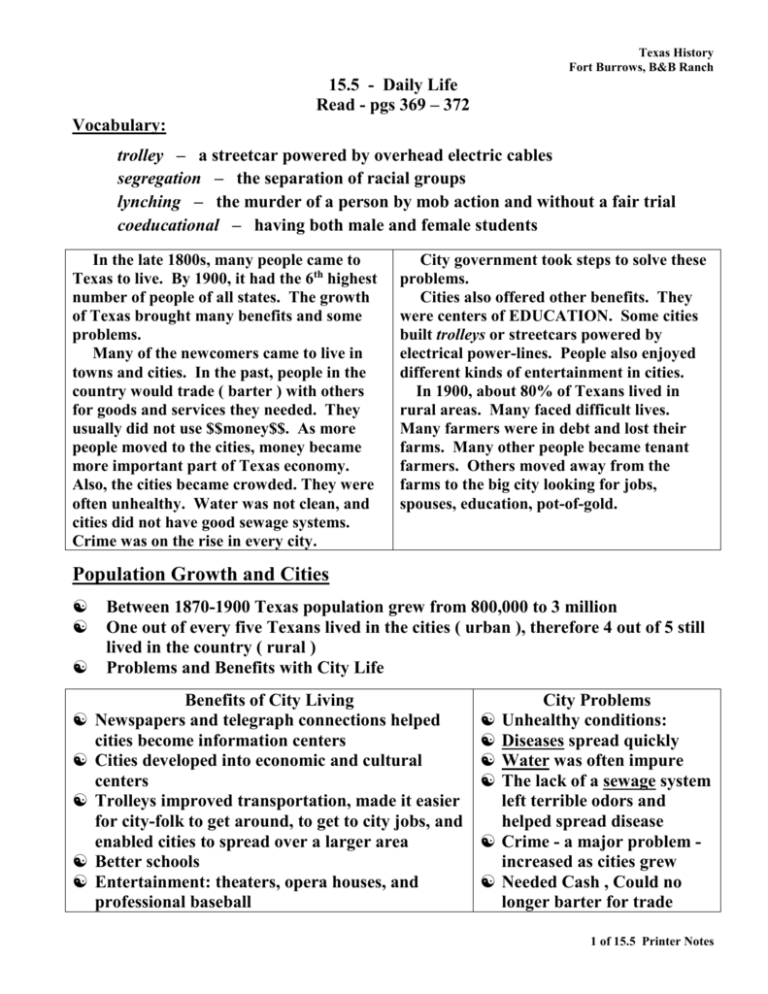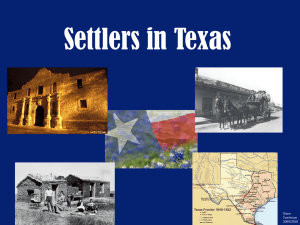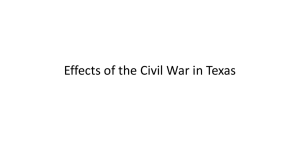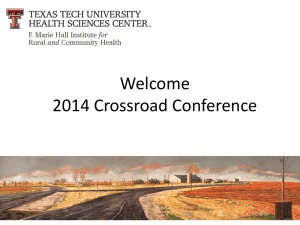Ch 15 Sect 5 Notes
advertisement

Texas History Fort Burrows, B&B Ranch 15.5 - Daily Life Read - pgs 369 – 372 Vocabulary: trolley – a streetcar powered by overhead electric cables segregation – the separation of racial groups lynching – the murder of a person by mob action and without a fair trial coeducational – having both male and female students In the late 1800s, many people came to Texas to live. By 1900, it had the 6th highest number of people of all states. The growth of Texas brought many benefits and some problems. Many of the newcomers came to live in towns and cities. In the past, people in the country would trade ( barter ) with others for goods and services they needed. They usually did not use $$money$$. As more people moved to the cities, money became more important part of Texas economy. Also, the cities became crowded. They were often unhealthy. Water was not clean, and cities did not have good sewage systems. Crime was on the rise in every city. City government took steps to solve these problems. Cities also offered other benefits. They were centers of EDUCATION. Some cities built trolleys or streetcars powered by electrical power-lines. People also enjoyed different kinds of entertainment in cities. In 1900, about 80% of Texans lived in rural areas. Many faced difficult lives. Many farmers were in debt and lost their farms. Many other people became tenant farmers. Others moved away from the farms to the big city looking for jobs, spouses, education, pot-of-gold. Population Growth and Cities Between 1870-1900 Texas population grew from 800,000 to 3 million One out of every five Texans lived in the cities ( urban ), therefore 4 out of 5 still lived in the country ( rural ) Problems and Benefits with City Life Benefits of City Living Newspapers and telegraph connections helped cities become information centers Cities developed into economic and cultural centers Trolleys improved transportation, made it easier for city-folk to get around, to get to city jobs, and enabled cities to spread over a larger area Better schools Entertainment: theaters, opera houses, and professional baseball City Problems Unhealthy conditions: Diseases spread quickly Water was often impure The lack of a sewage system left terrible odors and helped spread disease Crime - a major problem increased as cities grew Needed Cash , Could no longer barter for trade 1 of 15.5 Printer Notes Texas History Fort Burrows, B&B Ranch Rural Communities In 1900, Texas was still a mostly rural state West Texas had little ‘rainfall’ and ‘trees’ for timber Farmers in West Texas struggled with droughts; many gave up and left the area Ranchers had more success during these years, because cattle adapted better to the dry conditions Farmers were getting low prices for products and charged high prices from Railroads Many farmers were forced to sell their farms and take other jobs Tenant farmers in deep debt African Americans and Tejanos endured segregation in schools and the workplace. Lawlessness and biased viewpoints often resulted in violence against African Americans and Mexican Americans Railroads in Polk County boosted the lumber industry The Native American tribe, ( only one Indian reservation remained in Texas ) Alabama-Coushatta, become mill worker This greatly improved their economic life Civil Rights Following the Civil War few white Texans accepted racial equality In the 1890s, the state passed Jim Crow Laws Forbade African Americans from riding in the same train cars and attending the same schools as whites Supreme Court Case: 1896 Plessy v. Ferguson Said segregation was legal as long as facilities were “separate but equal” They were always separated , but rarely equal Group Difficulties White Texans fought for legal segregation of racial groups. Jim Crow laws enforced the segregation of African African Americans. They could not ride in the Americans same train cars or attend the same schools as white Texans. Between 1870 and 1900, more than 500 African Americans were lynched in Texas ,murdered by mob action without a fair trial Native Lived on Reservation in East Texas and struggled Americans to survive for many years Successes African Americans took advantage of what schooling they had; rate of people who could not read was cut in half When Railroads came to the area in the 1800s, lumber industry there grew, creating jobs for them 2 of 15.5 Printer Notes Texas History Fort Burrows, B&B Ranch Some ran Mexican Mexican Americans also experienced segregation. businesses and Americans Many were restricted to low-paying, unskilled ranches; many jobs. Most were prevented from voting helped preserve their culture Married women could not buy or sell property Entered teaching Women without their husband’s permission. Women could profession; were not sue in court, serve on juries, or vote. Few had able to attend and jobs outside of the home. Most ‘working’ women earn degrees from became school teachers. some universities Gains by Women In 1865 Baylor University became the 1st college to allow women (coeducational) 1898, DBU – Dallas Baptist University – Go Patriots!!!!! By 1900, female teachers outnumbered male teachers Women began to study to become nurses, doctors and lawyers 3 of 15.5 Printer Notes Texas History Fort Burrows, B&B Ranch 4 Types of Land Grants in Texas Internal Improvement Grants - grants given to companies to develop transportation or industry within the state. Loan Grants - Grants given to people to raise money or to pay-back loans made to the state. Military Grants - Grants given to people who fought for Texas. School Grants - Grants used to raise money for public schools. 1. 2. In the 1800s, most white Texans believed in… A. racial equality B. C. women’s suffrage D. legal segregation civil rights for all One of the first professions available to Texas women was… A. meatpacking B. the legal profession C. railroad work D. teaching 3. What were some of the advantages and disadvantages of city life ? _________________________________________________________________________ _________________________________________________________________________ ________________________________________________________________________. 4. What problems confronted Texas farmers ? _________________________________________________________________________ _________________________________________________________________________ ________________________________________________________________________. 5. What hardships did African Americans, Tejanos, and women in Texas face ? _________________________________________________________________________ _________________________________________________________________________ ________________________________________________________________________. 4 of 15.5 Printer Notes









